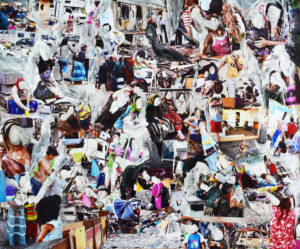Identities, issues of prejudice, exclusion, discrimination and racism occupy a central place in the artistic and activist work of Luna De Rosa. Her works are paintings and photographs of elusive bodies, scattering, expanding and multiplying, unstable and hybrid identities, fragility and feelings of loss. While expressing the relationship between the body and the social context that governs it, and essentially defines it, De Rosa raised awareness of the vulnerability of many ethnic minorities, especially the Roma, who face discrimination, racism and hostility, which often forces them to conceal their identities. Achieving a synthesis of one’s individual and collective being is difficult for everyone, says De Rosa, and even more so for those who do not have the cognitive tools and an adequate level of education to think about it.
I dream of painting through textiles, multimedia, sound any other materials or languages that can help people increase awareness of unconscious and conscious states of life. I am interested in all manifestations of reality, and the place where all things around us have begun.
According to the philosopher Gilles Deleuze, the first moment of giving and receiving a name is in itself “the highest point of depersonalisation” because it is here that one acquires “the most intense discernibility in the instantaneous apprehension of the many multiplicities”̀ that belong to it. A part of her family comes from the Roma diaspora, which marked her childhood, as well. As the daughter of a Roma man and a non-Roma woman, she has experienced double discrimination, both within and outside her own family. During her studies at the Academy of Fine Arts in Milan, she began to develop a deeper sense and critical understanding of art and the influence of the media on the individual and society in general. The Brera Academy, as well as her Erasmus year at the Academy of Fine Arts in Vienna, provided her with the opportunity to create and exhibit her paintings, sculptures and videos, and incentive exchanges with professors and colleagues were the basis of her understanding of how art can play a crucial role in cultural and political debates, but also how to find one’s position in it.
Marginalisation or feeling ‘different’ offered me a way of looking at, imagining alternatives and new worlds. In this sense, art, I believe, can serve as a platform for social change! For people like me who blend into Italian society or others, but at the same time are careful to reveal their roots/identities, art becomes a way or rather an opportunity to meet and relate to the stories and backgrounds of Roma, and all ethnic minorities, whose depersonalising effect of certain negative or traumatic events, through the sharing and affirmation of common experiences, has translated “this negativity” into resistance. Resisting, as Rosi Braidotti also says, means sustaining pain without being annihilated by it and engaging on the positivity front by catalysing the construction of contexts in which it is possible to transform negative passions and impulses into the “here and now” of concrete relationships. In the face of so many crises in the world, culture is more necessary than ever! For me, as for most women artists, it represents an opportunity for self-empowerment and understand the phenomenon of intersectional structure affecting in all ethnic minorities.
This artist who lives in Berlin and Milan takes the best of both cities – in the latter she comes hungry for culture, but also with the intention of showing everyone that the “Gypsy” can be educated and play important roles in society, as well. She arrived in Milan from a small town in Abruzzo, from a humble and traditional family, which soon became her second home, where she built her new identity, while at the same time hiding the Roma one, in order to study and pursue her career. Talking about Roma and Sinti is still taboo in Italy, and only recently have some voices begun to be heard, although there are several activists who have been fighting against exclusion and discrimination for several years. In Berlin, where she comes to do an internship, she, however, finds her freedom – first of all, the freedom of choosing the identity she wants to identify with, but also that of artistic expression that has developed in contact with the diversity of personalities she has had the opportunity to meet over the years. Milan is where I feel Italian and where I find myself with my language, with part of my culture. It is where I artistically started a journey and where I gladly return to follow important cultural events. Berlin is the city where you can take a chance and where if you want you can also make yourself heard politically.
One, none, a hundred thousand
One of the realities is certainly that in recent years the interdisciplinary debate on the art and life of Roma and Sinti in Europe has been intensified, thanks to various organizations and activists who continue to fight against discrimination and above all help young Roma to educate and to learn about their own history. It is a long process, because as we all know our history has been described for millennia by white supremacy and we have accumulated years and years of trauma and frustration, which perhaps and I hope only in five or more generations we will be able to distance ourselves from this anger, insecurity that we harbour inside. Art has always been a tool for communicating with the outside world, and for us Roma it has been even more so, to fight oppression and all kinds of discrimination.
Contemporary art of Roma communities aims to raise awareness and bring a voice into the current public discourse in Europe, especially in a time like ours, where history becomes news, but not because it is contemporary, but because it is told to us in real time, with syntax between realism and fantasy, De Rosa points out. The media system has compromised the possibility of the deposition of historical memory, it has modified the imaginary, swallowed myths, opening up new scenarios in, as she puts it – perceived reality. This is why art as activism becomes a way to address the urgency of challenging the misunderstandings, stereotypes and controversies surrounding the names used to address the Roma comunities. Romnja artists, or like me, half Cagi and half Roma, imagine a Europe in which truths are revealed, starting with self-repair!
Part of today’s social structures and systems – police violence against Roma and other racialized people occurs across Europe and only very rarely do those affected and their relatives experience justice. This is why it is important that there is solidarity between us, in organizing, educating and respecting each other in our religious and cultural differences, without forgetting that we come from the same diaspora and what unites us in all these differences is precisely the Romanipé.
Like many other women artists, she also tries to resist the classification and the form of strengthening discrimination, so she does not like to be described as inevitably and solely- a Roma artist and a writer. And unfortunately today, in the society of short-term convenience, many people use this word to call attention to the market, without really paying attention to the multiple identities of the Roma cultural and psychological heritage. She considers that identity is still an often misused term when we still believe that we can classify it in a category as “Roma” or “European“.
This is also the starting point of her latest series of works “Cosa vuol dire essere Romnia ?!” arising from the fact that there is no such identification, but there are various circumstances that make up the identity in motion and in continuous transformation. Thus her identity represents a dilemma, it is manifold, fluid, and open. Each of us can be, as the writer Pirandello says, ‘one, none, one hundred thousand’. I would definitely prefer women to be seen as they themselves prefer to be seen and for each of us to bring our own backgrounds and notions of culture into our careers without being labeled.
As De Rosa continues, class, ethnicity and gender, unfortunately, do not only interfere with artistic careers but are present in other professions and creations as well. For this reason, she had to hide a part of her identity, and recalling the past, she states that in her hometown she has been rejected only due to her last name and that her father had a hard time finding a job because he was a Roma. As well as in Italy the still strong discrimination against genders, who are not free to express their sexuality and in most cases, in addition to being marginalized live their sexuality as a defect dictated by public opinion and leading them to enclose their existence and their relationship with their bodies in a sort of frailty, locked in their own emotional and psychological dimension.
Suppressed humanity
In response to the need for social inclusion that provides equal opportunities, the Union of Roma Communities in Italy (UCRI platform) was founded, which was also joined by De Rosa. Her contribution as an artist, writer and producer is public exposure and improvement of the Roma culture through various cultural events, workshops against anti-Romaism, organizing language, history and art courses. Those gathered around the platform are organizing the first national art competition on Samudaripen, founded by Gennaro Spinelli, in which both Roma and non-Roma can participate with their works of art, all for the purpose of educating and recognizing Samudaripen in Italy, which is still unknown to many young Roma, and above all even greater mystery to the non-Roma population.
One of the goals of the UCRI platform is also the fight against the structures of “nomadic camps”, and De Rosa, through two collages entitled “Roma Camps in Italy – the architectural expression of state racism”, has portrayed the reality of a place where humanity is made up of the weakest individuals and of those considered to be “excesses”, who are left to fend for themselves in the face of the current crisis. Through photographs of nomadic camps found in various Italian online newspapers, she saw the way in which politicians like Salvini used racist propaganda by replicating social divisions and disregarding the plurality of society, while at the same time illustrating the degradation of people living in extreme social marginalization. Through the collage she wanted to present the way the Roma are projected and deceived by mass visualization, and to intervene especially in people’s faces by painting, precisely because their bodies and identities are invisible to the public opinion, yet are already used to violently represent stereotypes of typical Roma.
Roma camps are a journey into the reality of permanent discrimination, observes De Rosa, and further states: As for the Roma are always represented in Italy by the media as a thief, a criminal, who does not want to integrate and instead prefers to live in decay. It is thought that for the Roma to live in degradation is normal, or even wanted, they themselves want it, that is, they want to pass as normal what is instead inhumane. So the so-called nomads are not even nomads by culture. The nomadic camps should be called “social trash cans”. The money that should be destined for the integration of the Roma, the so-called European funds, is used for evictions, under the indifferent gaze of public opinion that does not understand, cannot understand.
Body – as a subject and object
The body has always been a writing surface for receiving the visible text of the law that society dictates to its members, branding them, continues De Rosa. Every scar is an indelible stain, a sign that makes the body memory. That is why archaic societies initiated adolescents into social life with the ritual of torture, she adds and continues that by marking the body, they de-designated it as the only space suitable for bearing the ‘sign’ of the group, the ‘trace’ of the passage that ‘marks’ the individual to society. Since innocence is therefore impossible because the freedom of others also involves us, then our existence is from the beginning a co-existence, and there is no moment in which our individuality is not enveloped in that atmosphere of sociality. Thus the body as a means tells the story of her life, intimate and private, but also the story of social and political events, in the boundary space between reality and imagination.
Existence relates to bodies and the world through different perceptions. For example, in the traditional Italian Roma families of old settlement, there is a dualistic perception of the world and all aspects of life are divided according to the concepts of luck/unluck, honor/shame and pure/imperfect. The human body is divided into pure and impure parts: the upper part is pure and the lower part impure. The woman is considered to have great power to ‘ contaminate’ a man or food, as female sexuality is considered impure. Women must be careful about their movements and postures, especially their legs, which must always be kept tight and closed, never spread when sitting, and must never bend forward from a standing position. The clothing, demeanor and behavior of women are the constant objects of public scrutiny by the entire community.

At the end of the day, De Rosa believes, her non-Roma grandmother lives in this perspective as well. Culture, gender, multiplication of identities, different perspectives and values, as well as discrimination need to be explored through an intersectional approach due to the fact that many women, for example, have to confront heteronormativity, ageism and other forms of discrimination that make their positioning within patriarchal and ethnicized societies more complex says De Rosa. This means that it is necessary to question the existence of the essences that make us ‘women’. Identity is socially constructed and contested, which is why it is of paramount importance that Roma women, affected by inequality and in many cases by poverty, exclusion and discrimination, are finally seen with their true biographies and identities! In other words, to recognize that Roma women are today as capable of mobilizing around different issues, that they are capable of educating themselves and others and of occupying certain positions. Visualization is today the primary form of success, control and commodification! Technology commodifies every body and at the same time intensifies structural differences and inequalities.
Through these “dominant regimes of representation” of the group De Rosa can see herself as ‘others’, and in which case the images play a key role in defining and controlling the political and social power to which both individuals and marginalized groups have access. Today, more than ever, it is no longer a question of ‘identity’, but rather of who you belong to and I believe that the body today has lost its own matter. The body has been deprived of the centrality it had always occupied in the world to put it at the disposal of its image, which is certainly more reassuring and more appropriate for a role in the media and in the market. For this reason, the identities and bodies of women, visible or seen as ‘others’, play a central role in her creative work as a subject and object of the violence and exclusion dictated by society. Women artists continue to be dramatically underrepresented and underestimated in museums, galleries and auction houses, where their role stems from the position of a woman in the broader social structure set by society. Each of their appearances at biennales and festivals is of the utmost importance, and for De Rosa as one of the guest artists at this year’s Villa Romana program in Florence, this opportunity represents an important moment, a redemption that she longed for yet as a child, but also the faith and hope that every one of us must have for ourselves and for what we believe in. And it gives me the confidence to think that it is necessary for Roma women, who still face discrimination, and especially for young people, to have figures who can be an example and courage to feel that they are not alone, but rather bring interest and curiosity in learning about their own history and background and educate themselves for a better future.














